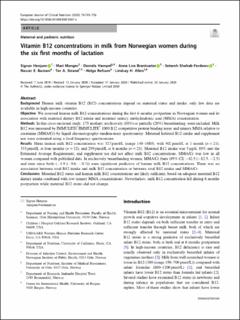| dc.contributor.author | Henjum, Sigrun | |
| dc.contributor.author | Manger, Mari Skar | |
| dc.contributor.author | Hampel, Daniela | |
| dc.contributor.author | Brantsæter, Anne Lise | |
| dc.contributor.author | Shahab-Ferdows, Setareh | |
| dc.contributor.author | Bastani, Nasser Ezzatkhah | |
| dc.contributor.author | Strand, Tor A | |
| dc.contributor.author | Refsum, Helga | |
| dc.contributor.author | Allen, Lindsay H. | |
| dc.date.accessioned | 2023-05-08T10:18:16Z | |
| dc.date.available | 2023-05-08T10:18:16Z | |
| dc.date.created | 2020-01-31T12:52:51Z | |
| dc.date.issued | 2020 | |
| dc.identifier.citation | European Journal of Clinical Nutrition. 2020, 74 (5), 749-756. | |
| dc.identifier.issn | 0954-3007 | |
| dc.identifier.uri | https://hdl.handle.net/11250/3066826 | |
| dc.description.abstract | Background: Human milk vitamin B12 (B12) concentrations depend on maternal status and intake; only few data are available in high-income countries. Objective: We assessed human milk B12 concentrations during the first 6 months postpartum in Norwegian women and its association with maternal dietary B12 intake and maternal urinary methylmalonic acid (MMA) concentration. Methods: In this cross-sectional study, 175 mothers, exclusively (80%) or partially (20%) breastfeeding, were included. Milk B12 was measured by IMMULITE®/IMMULITE® 1000 B12 competitive protein binding assay and urinary MMA relative to creatinine (MMA/Cr) by liquid chromatography-tandem-mass spectrometry. Maternal habitual B12 intake and supplement use were estimated using a food frequency questionnaire. Results: Mean human milk B12 concentration was 327 pmol/L (range 140-1089), with 402 pmol/L at 1 month (n = 21), 333 pmol/L at four months (n = 32), and 299 pmol/L at 6 months (n = 21). Maternal B12 intake was 5 µg/d, 89% met the Estimated Average Requirement, and supplement use did not affect milk B12 concentrations. MMA/Cr was low in all women compared with published data. In exclusively breastfeeding women, MMA/Cr (beta (95% CI) -42.5 (-82.5, -2.5) and time since birth (-4.9 (-9.6, -0.3)) were significant predictors of human milk B12 concentrations. There was no association between total B12 intake and milk B12 concentration or between total B12 intake and MMA/Cr. Conclusions: Maternal B12 status and human milk B12 concentrations are likely sufficient, based on adequate maternal B12 dietary intake combined with low urinary MMA concentrations. Nevertheless, milk B12 concentration fell during 6 months postpartum while maternal B12 status did not change. | |
| dc.language.iso | eng | |
| dc.relation.uri | https://www.nature.com/articles/s41430-020-0567-x.pdf | |
| dc.title | Vitamin B12 concentrations in milk from Norwegian women during the six first months of lactation | |
| dc.type | Peer reviewed | |
| dc.type | Journal article | |
| dc.description.version | publishedVersion | |
| dc.source.pagenumber | 749-756 | |
| dc.source.volume | 74 | |
| dc.source.journal | European Journal of Clinical Nutrition | |
| dc.source.issue | 5 | |
| dc.identifier.doi | 10.1038/s41430-020-0567-x | |
| dc.identifier.cristin | 1788099 | |
| cristin.ispublished | true | |
| cristin.fulltext | original | |
| cristin.qualitycode | 1 | |
